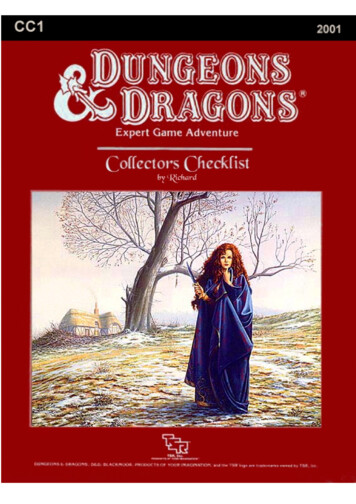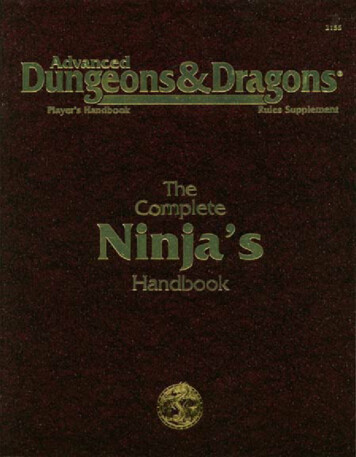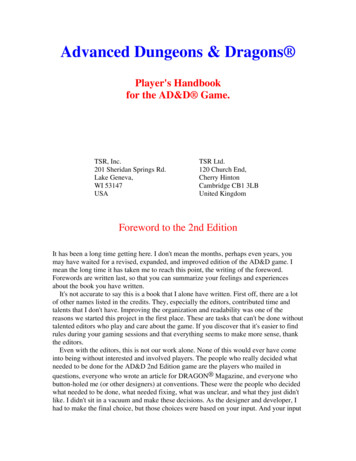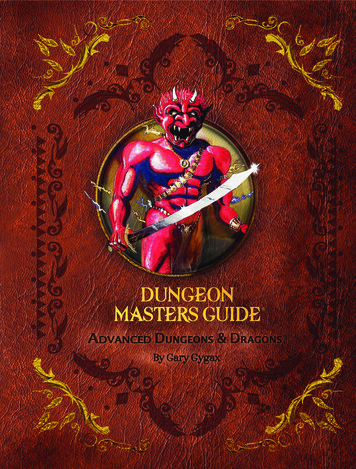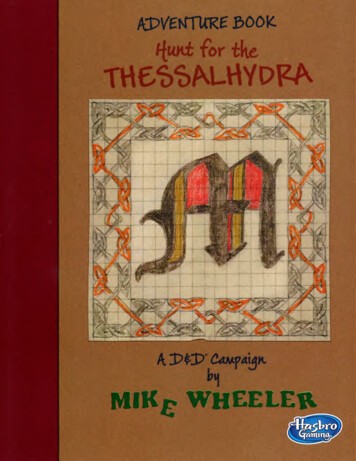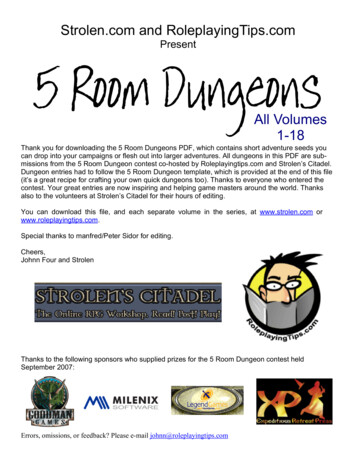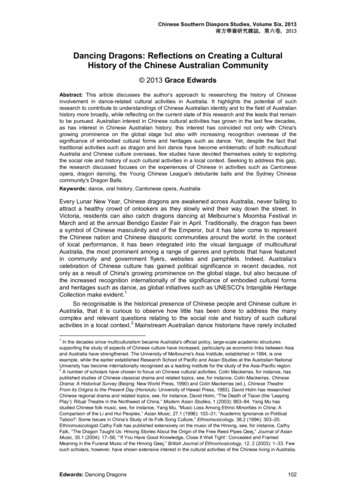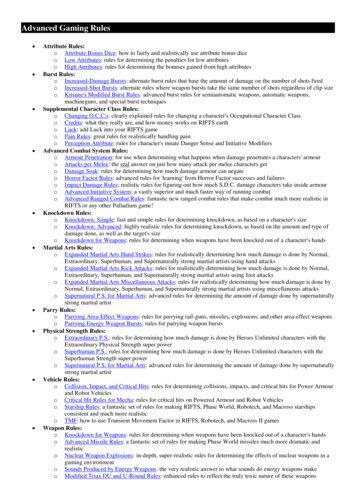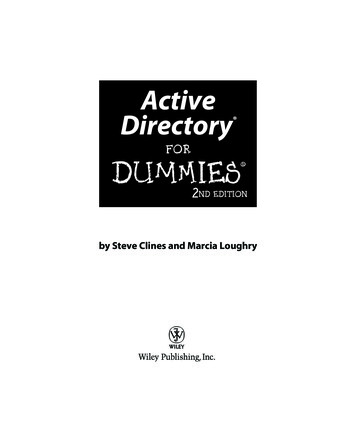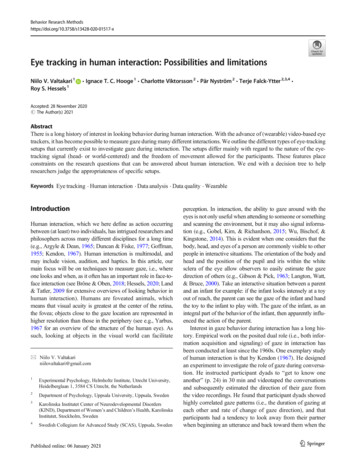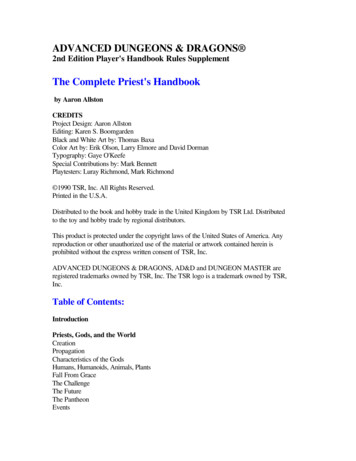
Transcription
ADVANCED DUNGEONS & DRAGONS 2nd Edition Player's Handbook Rules SupplementThe Complete Priest's Handbookby Aaron AllstonCREDITSProject Design: Aaron AllstonEditing: Karen S. BoomgardenBlack and White Art by: Thomas BaxaColor Art by: Erik Olson, Larry Elmore and David DormanTypography: Gaye O'KeefeSpecial Contributions by: Mark BennettPlaytesters: Luray Richmond, Mark Richmond 1990 TSR, Inc. All Rights Reserved.Printed in the U.S.A.Distributed to the book and hobby trade in the United Kingdom by TSR Ltd. Distributedto the toy and hobby trade by regional distributors.This product is protected under the copyright laws of the United States of America. Anyreproduction or other unauthorized use of the material or artwork contained herein isprohibited without the express written consent of TSR, Inc.ADVANCED DUNGEONS & DRAGONS, AD&D and DUNGEON MASTER areregistered trademarks owned by TSR, Inc. The TSR logo is a trademark owned by TSR,Inc.Table of Contents:IntroductionPriests, Gods, and the WorldCreationPropagationCharacteristics of the GodsHumans, Humanoids, Animals, PlantsFall From GraceThe ChallengeThe FutureThe PantheonEvents
Forces and PhilosophiesMythic History Creation SheetDesigning FaithsGod, Force, or PhilosophyEthos and Requirements of the FaithGoals and PurposesAlignmentMinimum Ability ScoresRaces AllowedExperience and SpellProgressionGender RequirementsNonweapon and WeaponProficienciesDuties of the gVigilanceRights of the PriesthoodChurch TrialCoronationOther ConfirmationsTithesSeparation From the FaithRuleThe State ReligionRestrictions on the t PointsMagical ItemsMutilationWeaponsSpheres of InfluenceGranted PowersHigh PowersMedium PowersLow PowersOther Powers
Followers and BelieversWhat Are They?Who Are They, and How Do They Know to Arrive?How Many and How StrongAre They?How Much Control Does the Priest Have?What If They Die Or GainExperience?What If The Priest-CharacterIs Scum?Role of the FaithRelations With Other FaithsRelations With theAristocracyRelations With the PeopleRelations With Foreign FaithsRites and the CalendarHierarchy of the FaithExperience Levels and the HierarchyPC Priests and the HierarchyFinances of the PC's TempleNon-Priests Working For the FaithPCs, Forces and PhilosophiesFaith Design SheetSample rtsBirth, ChildrenCommunityCompetitionCraftsCulture (Bringing Of)Darkness, NightDawnDeathDiseaseDivinity of Mankind(Philosophy)DruidEarthElemental Forces (Force)Everything
Evil (Philosophy)Fate, DestinyFertilityFireFortune, LuckGood (Philosophy)GuardianshipHealingHuntingJustice, RevengeLife-Death-Rebirth Cycle(Force)LightLightningLiterature, , TrickeryMoonMusic, DanceNatureOceans, RiversOracles, ProphecyPeaceProsperityRaceRedemptionRulership, KingshipSeasonsSitesSky, dWisdomCombining Traits in OnePriesthoodMultiple Priest Classes
Revised Priest ClassesMulti-Class CharactersPriest KitsKits and the Priest ClassesKits and Character CreationThe Priest KitsAmazon PriestessBarbarian/Berserker PriestFighting-MonkNobleman PriestOutlaw PriestPacifist PriestPeasant PriestProphet PriestSavage PriestScholar PriestRecording Kits on the Character SheetMulti-Class and Dual-ClassCharactersAbandoning KitsModifying and Creating KitsRole-PlayingPriest PersonalitiesThe CrusaderThe Earnest NoviceThe HypocriteThe MotivatorThe PhilosopherThe PoliticianThe ProselytizerThe Sage CounselorChanging Personality TypesAll Sense and No BrainsPriest AdventuresAdvisor of the FaithfulAgent of the PriesthoodDefender of the FaithDefender of the FaithfulMartyr for a CauseServant of the GodRites and Role-PlayingAtonementCalendar CeremoniesCommunion
Confirmation of AdulthoodConfirmation of mingPrayerPurificationSacrificePriests and PunishmentMinor OffensesInappropriate Weapon and Armor UseBetrayal of GoalsDivine RetributionsSociety's PunishmentsWhen Priests Renounce Their FaithWhen Gods Bestow SpellsPriestly FollowersToning Down the ClericEquipment and CombatPriestly ItemsThe CanonHoly SymbolHoly WaterPriestly VestmentsNew WeaponsNew Weapons ListNew Weapons DescriptionsUnarmed CombatAttacking Without KillingKnowing Punching, Wrestling, Martial ArtsMartial Arts ResultsSpecializing in PunchingSpecializing in WrestlingSpecializing in Martial ArtsMore Than One StyleContinuing SpecializationBibliographyIntroduction
Since the creation of the ADVANCED DUNGEONS & DRAGONS game system, thecleric has been one of the most popular character classes. He has been a happy bridgebetween warriors and mages: Capable of armoring up and wielding heavy weapons,capable of casting useful magics, he was a very versatile adventurer and the favoritechoice of countless players.With the release of the AD&D 2nd Edition game, none of that has changed. Thecleric is the same magic-hurling, mace-wielding hero that he always was. And in TheComplete Priest's Handbook , we're going to see to it that he's even more than that.In this supplement, we're going to elaborate on what the priest (including the cleric) isto the campaign, to the setting's civilization, and to the adventuring party.We'll be providing guidelines for the DM to work up the cleric's faith: The god orphilosophy he serves, the rules and mores he follows, the duties he practices, therestrictions he suffers, the powers he possesses, and the relations he and the others of hisfaith have with the followers of other faiths.We'll show you how to work up priests devoted to specific mythoi. The druid, from theAD&D 2nd Edition Player's Handbook, is one example; this supplement describesmany, many more, and provides rules for the DM to create new priesthoods of his owndesign.We'll talk about priestly orders. Some priesthoods have soldierly orders, scholarlyorders, missionary orders, oracular orders, and many other types. If your priest characterbelongs to a faith with several orders, he may choose one of them, which will give himspecial abilities and duties beyond those of ordinary priests.We'll talk about role-playing the priest character. Certainly, priest characters don't haveto have the same sort of identical personality (the kindly father-confessor with the bloodymace in his hand) which many players imagine them all to have.We'll describe whole campaigns devoted to priests: How to run them, how to givethem a purpose, how to determine what goals and interests are most appropriate.And we'll talk about the sort of equipment that priests use in their devotions andadventures, including weapons, armor, holy symbols, priestly vestments, and other items.The Complete Priest's Handbook is equally useful if you're a Dungeon Master or aplayer. It will add depth to the campaign world and the range of NPCs for DungeonMasters, and add detail to the abilities, backgrounds, and responsibilities of playercharacter priests.***In the text, for reasons of simplicity, we normally use masculine nouns and pronounsinclusively. When we say "god," "priest," or "man," we're normally also implying"goddess," "priestess," and "woman."In order to be able to use this supplement, you must use the Weapon and NonweaponProficiencies rules from the AD&D 2nd Edition game. If you're not yet familiar withthem, you ought to read them before continuing in this rulebook.A special note for those of you who are using this Complete Priest's Handbook with youroriginal AD&D game instead of the new edition: This supplement mentions a lot ofpage numbers from the Player's Handbook and the DMG. The page numbers cited are for
the newest edition, not the original; they won't be correct for those of you using the oldbooks.Priests, Gods, and the WorldThis chapter is for DMs who want to design the mythic history of their campaignworld(s). It's not prohibited for the campaign's players to read this . . . but not all of themwill find it useful. Players may wish to skip on to the third chapter, "Sample Priesthoods."One of the first things the DM can do to add color and detail to his campaign world isto work up that world's mythic history. Such a history will help establish, in his mind andthose of his players, the relationships between the gods, and between gods and men. Itwill help set the tone of the campaign and the attitude of the player-characters' culture. Itwill give the players some idea of what their characters expect from their gods and theirfuture. And once it's done, the DM can then elaborate on it and decide how eachindividual god relates to other gods and to the sentient races of the world.In this chapter, we'll discuss some of the common themes that run through myths; theDM can use these topics as a framework for his own mythic history.CreationThe first place to start is the creation of the universe and the world.In most creation stories, there was usually some disinteresting, stable condition ineffect at the dawn of time. It might have been a formless void, or darkness, or unendingice and snow.Then, we have the first great being, the one who brings about creation of the world.Note that this great being doesn't have to be the god who is now dominant in thecampaign world. The myths are packed with tales of gods who created their worlds,became oppressive, and were then cast down by other gods, even their own children, whonow rule in their place.Nor does the creation have to have been a deliberate event. It might have been anaccident; the god could have been dreaming and his dreams became reality.The creator could be a tremendous monster, one which began the process of creatingthe world, but was overthrown before it finished making the world to its own satisfaction. . . and one which, legends say, will return some day to finish the job.It could be a simple creature, one not necessarily deserving of worship, which shapesthe world simply by acting as the animal it is. As one example, if the original state of theuniverse were a giant block of salt, this creature could be a giant cow which licks it intothe shape of the world.In some mythologies, the great being that shapes the world stays around after that taskis done; he or she might be the principal deity of the world. More often, that great beingperishes, or is cast down by descendants, or settles for a lesser role once creation isaccomplished.Basic Astronomy
What is the shape of the world and the universe once they are created? What are suns,moons, planets and stars?The entire universe could be a single huge world, with a dome overhead which holdsthe stars and confines the sun(s) and moon(s). The world could be a disk, a sphere, abowl, or an unending surface continuing in all directions to infinity.The sun and moon could be glowing chariots, or bright gods continually flying acrossthe sky (perhaps as a service to the world, perhaps because they're being chased). Theycould be worlds unto themselves, and the player-characters might someday have theopportunity to visit and walk the bright surface of the sun in search of adventure. Theycould be the great, glowing eyes of the most powerful deity. They could be gigantic,fiercely-burning lamps created by the craftsman-god, lamps which circle the world onsome giant mechanism. (Perhaps, instead of circling the world, they just shut off each daywhen the time is due; the sun just turns off, and the moons just turn on.) They could evenbe suns and moons as we understand them, though some of the charm of fantasy liesprecisely in making such things different from our cold, modern explanations of them.The planets and stars could be holes in the dome of the sky, suggesting that there is agreat brightness beyond. They could be decorations placed in the sky by the gods. Theycould be worlds unto themselves. They could be glowing creatures forced to trace pathsthrough the sky every night. They could be the suns of distant worlds.And, of course, the DM can choose for all these astronomic bodies to be one thing, butfor the prevailing belief of the people to be different, an incorrect belief; nothing says thatthe world's deities want the humans and demihumans to know the truth.Effects of Terrain on CreationIn the real world, the terrain of the human culture to which a mythology belongedoften had a strong effect on the myths. Norse mythology started with a huge abyss filledwith ice, for instance.If one race's religion is dominant in the campaign world, the DM should decidewhether or not their creation-story has a setting like the land where that race originated.In a fantasy world, this situation could come about from one of two reasons:The gods, having emerged from a particular type of terrain, would find similar terrainin the mortal world to be their favorite land for creating new races, exploring, andinteracting with humans; orThe sentient races might have erroneously re-interpreted the story of the world'screation as a reflection of the terrain in which they live, and the legend is simply wrong.PropagationOnce creation of the world and universe are established, the DM can move on to thepropagation of the gods. In other words, once the setting is in place, the cast of gods getslarger and larger.Naturally, the DM can always do this the other way around. Perhaps all the gods werein place before they decided to create the world. There's nothing wrong with this choice;it's simply backward from the way the best-known Earth mythologies operated.Regardless, unless the DM is creating a monotheistic faith (one dedicated to only one
deity), he must now begin creating the other gods of the faith.These gods could be children of the first great being. They could be that being'screations instead. They could be representations of natural forces brought to awarenessand life by the catalyst of Creation. They could emerge from some less wholesomeprocess (for example, they
choice of countless players. With the release of the AD&D 2nd Edition game, none of that has changed. The cleric is the same magic-hurling, mace-wielding hero that he always was. And in The Complete Priest's Handbook, we're going to see to it that he's even more than that. In this supplement, we're going to elaborate on what the priest (including the cleric) is to the campaign, to the .
